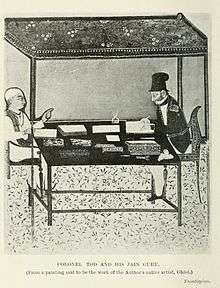Yati
| Part of a series on |
| Jainism |
|---|
 |
|
Jain prayers |
|
Ethics |
|
Major figures |
|
Major sects |
|
Festivals |
|
Pilgrimages |
|
|
Yati ("Jati" in vernaculars) historically was the general term for a Jain monk. In the late medieval period it came to represent a stationary monk, who lived in one place rather than wandering as required for a Jain monk.[1] The term was more common for the Śvētāmbara monastics, but was also used by the Digambaras. The term has also been occasionally for ascetics from other traditions.[2]
Some scholars married and were termed Sansari yati[3] or mahātmās.[4][5]
Some ruling dynasties in Rajasthan had a close relationship with yatis.[6] Abu'l-Fazl ibn Mubarak mentions that yatis were invited to participate in the discussion on religions.[7]
The stationary yatis often managed institutions and properties. Some of their residences are termed Jatiji in their memory.[8]
With reestablishment of orders of wandering (samvegi) monks since late 19th and early 20th century, the number of yatis have declined significantly.[9][10]
Shripujya
The heads of the institutions of Śvētāmbara Yatis were often termed Shripujya,[11] similar to Digambara institutions headed by the Bhattarakas. Only a celibate yati could become a Shripujya. They have now been replaced by Acharyas who head orders of wandering monks.
Prominent Yatis
- Yativṛṣabha, 500-570
- Yati Gyanchandra, who advised James Tod in studying and compiling information from annals of Rajasthan.
- Rajendrasuri who was initiated as a Yati and later helped transform the tradition in 1880.
- Yati Lavaji, the founder of the Sthānakavāsī sect about 1653
- Yati Yatanlal, (1894-1967) freedom fighter. There is an award named after him.[12]
Influence of Yatis
Many Yatis were very influential. One of the greatest Marwari trading firm Tarachand Ghanshyamdas was founded as the result of the blessings of a Jain Yati at Churu. The founder, Chaterbhuj, an Aggarwal Poddar, was a devotee of a Jain Yati. The Yati inspired him to go to Bhatinda.[13] which resulted in establishment of a India-wide trading empire. Tarachand Ghanshyamdas is considered to have spawned numerous Marwari trading houses, established by its clerks.
See also
References
- ↑ Jain Yati Parampara, Agarchand Nahta, Kesarimalji Surana Abhinandan Granth, 1982, p. 71-78
- ↑ http://dictionary.buddhistdoor.com/en/word/91233/yati Buddhist Dictionary
- ↑ The A to Z of Jainism Kristi L. Wiley, Scarecrow Press, Jul 16, 2009, p. 240
- ↑ http://www.bl.uk/onlinegallery/ttp/ramayana/accessible/pages21and22.html#content Ramayana - Pages 21 and 22, The colophon in red states that the text was written by the Mahatma Hirananda
- ↑ The Dabistán: Or, School of Manners: The Religious Beliefs, Observances, Philosophic Opinions and Social Customs of the Nations of the East, Fānī Muḣsin, Translated by David Shea, Anthony Troyer, M. Walter Dunne, 1901, p. 275-276
- ↑ पुरालेखा स्रोत, राहुल तनेगारिया, कतिपय जैन यति भी राज परिवारों की वंशावलियां रखते थे। खरतरगच्छ के जैन यति मारवाड़ राजवंश के कुलगुरु माने जाते थे।
- ↑ ,अकबर और तत्कालीन भारत, Ed. Irfan Habib, Rajkamal Prakashan Pvt Ltd, 2009 p. 104
- ↑ भाग्योदय संस्कार शिविर व रक्षाबंधन पर्व आयोजित, August - 2 - 2012, रोहतक, 2 अगस्त (हप्र)। झज्जर रोड पर स्थित जैन जतीजी में जैनाचार्य गुप्तिनन्दी जी गुरुदेव ने रक्षाबंधन के पर्व पर 15 वर्ष से ऊपर की आयु के सैकड़ों गुरुभक्तों को भाग्योदय के संस्कारों से संस्कारित किया
- ↑ The Penguin Handbook of the World's Living Religions, Penguin UK, Mar 25, 2010
- ↑ People of India: Rajasthan, K. S. Singh, Popular Prakashan, Jan 1, 1998 p. 991-994
- ↑ Gazetteer of the Bombay Presidency, Volume 9, Part 1, Bombay (India : State), Government Central Press, 1901, p. 109
- ↑ महासमुंद में बनने लगा जयपुर कृत्रिम हाथ,, Matrix News, Aug 05, 2013, मुख्य अतिथि श्री मालू ने कहा के यति यतनलाल समाज सेवी होने के साथ साथ एक स'चे देशभक्त थे. बचपन से समाज सेवा, देश सेवा में रूचि रखने वाले यति जी ने १७ जुलाई १९७६ में श्री विवेकवर्धन सेवा आश्रम की स्थापना कर आश्रम परिसर में सर्व सुविधायुक्त निशुल्क अस्पताल का शुभारंभ किया
- ↑ [Poddarji ka Gharana aur Poddarji, Jhavarmall Sharma, in Poddar Abhinandan Granth, Ed. Vasudevsharan Agrawal, Mathura Sam. 2010 (1953), Akhil Bharatiya Braj Sahitya Mandal, p. 10]
